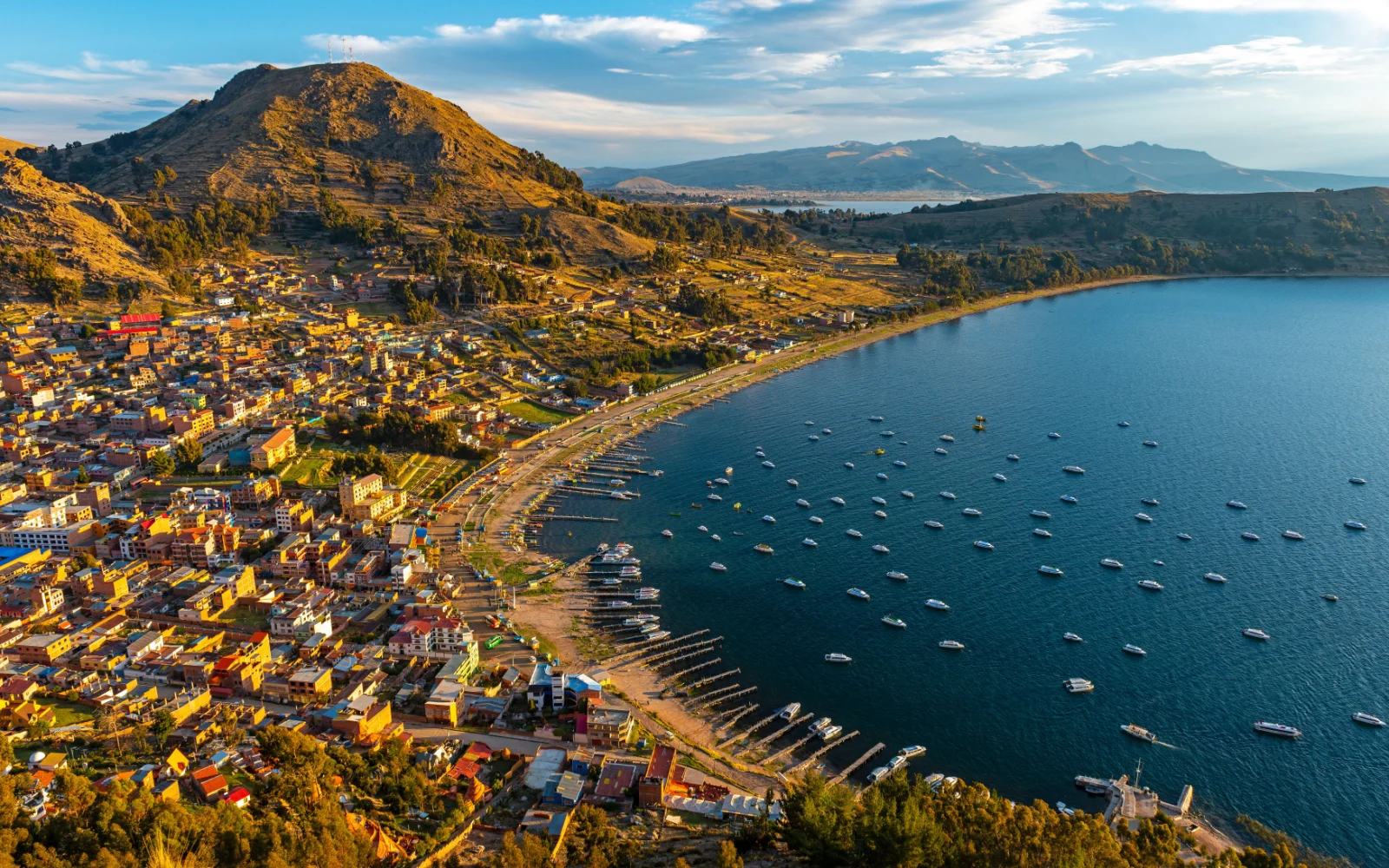Bolivia tends to be out of mind as it is almost always out of sight. Do some digging on your own and you’ll find this underrated country is quite interesting. If you are even slightly interested in wildlife, wrestling, or Latin America, you’ll appreciate Bolivia.
25 Fun Facts About Bolivia
Take a dive into the facts, stats, figures and trivia of Bolivia and you’ll have the urge to take a trip to this tropical getaway. Give Bolivia a chance and you’ll find it holds appeal to people of all ages and demographics. Here’s a quick look at the highlights of this unique Latin American country.
1. Bolivia Is the Home Of Cholita Wrestling
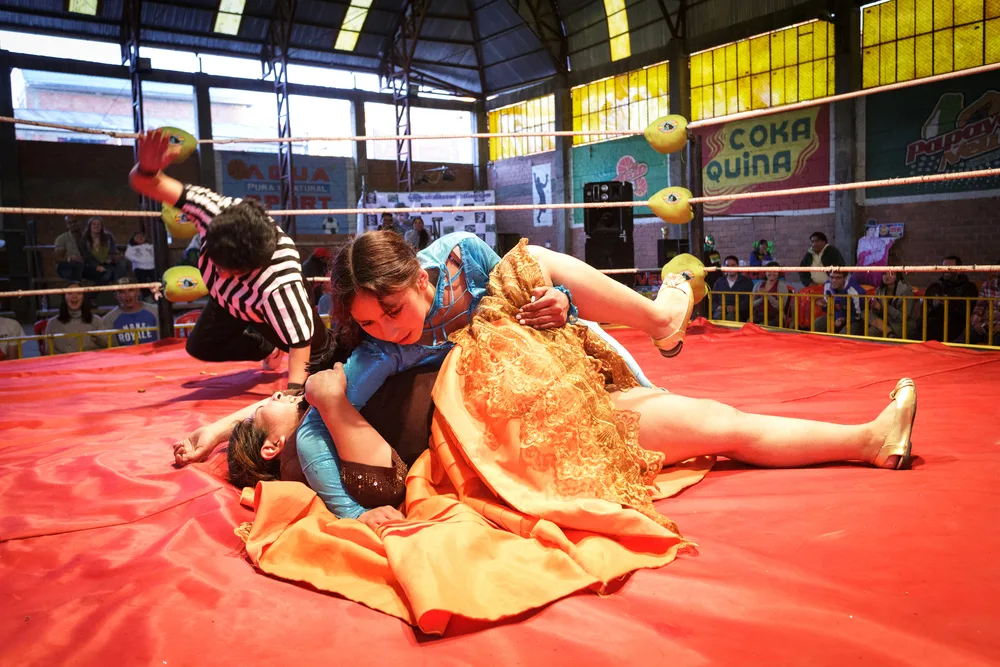
LA PAZ, BOLIVIA – SEP 13: Cholita wrestling is a touristic show. Cholita is the Bolivian women in traditional dress. September 13, 2015, La paz, Bolivia/sunsinger/Shutterstock
You won’t find Cholita wrestling anywhere other than Bolivia. Cholita wrestling is similar to regular wrestling yet the participants are indigenous Bolivian women. Local women entered the wrestling foray as a means of establishing social bonds and exercising for stress-relief.
Some Bolivians insist Cholita wrestling is a rebellious performative statement against the domestic violence. The matches typically begin with a theatric misogynistic attack against a Cholita wrestler who always emerges as the eventual victor.
Check out a Cholita wrestling match in Bolivia yourself, stay to the end and you’ll likely find it culminates in a triumphant body slam.
2. Bolivia Lets Visitors Ride the Most Dangerous Road in the World
Take on the country’s revered Most Dangerous Road In The World, more formally known as Death Road or North Yungas Road, and you’ll have a story that you never grow tired of telling.
Beware, as locals estimate several hundred people are injured or even pass away while cycling this challenging road each year.
Bolivia’s Death Road is laden with undulating mountain slopes, minimal visibility and few barriers. Government officials established a new road to connect with Death Road for safer traveling yet this unique challenge is still open to daring cyclists.
3. The Nation Is Especially Proud of Its First Indigenous President
Evo Morales was elected as Bolivia’s president in 2006. Morales served multiple terms, retaining a much-appreciated hold on office all the way through 2019.
Part of Morales’ border-to-border popularity is explained by the fact that he is the Latin American nation’s first-ever indigenous native to hold the highest office in the land.
Though some mainstream foreign media news outlets painted a picture of a controlling leader when characterizing Morales, the truth is his public service was an economic boon.
4. Bolivia Has Two Separate Voting Ages
Here’s a shocker: Bolivia has two distinct age requirements for voting. A prospective voter’s marital status determines temporal eligibility to vote. Those who are married are legally permitted to vote when reaching the age of 18.
Those who are single are required to wait until the age of 21 to vote. Moreover, voting in Bolivia is mandatory, meaning everyone is required to participate in the democratic process.
5. Bolivia’s Name Has Been Shortened
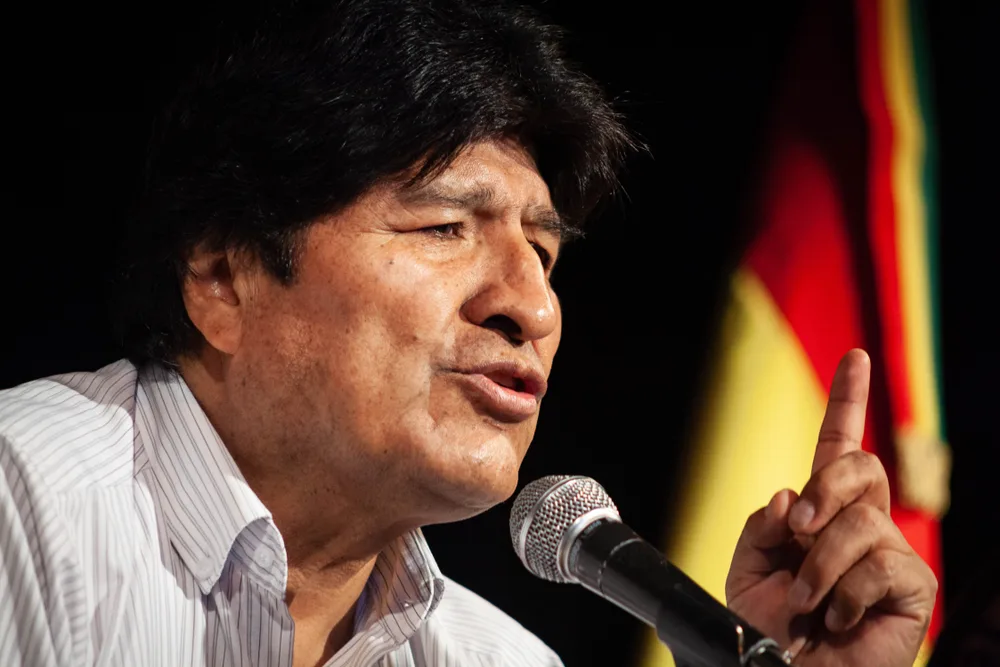
Evo Morales, president of Bolivia, isolated in Argentina, giving a press conference in Buenos Aires, 17-12-19/Paula Acunzo/Shutterstock
Can you image saying you are from the Plurinational State of Bolivia? Though media outlets rarely touch on it, the truth is Bolivia is an abbreviated nation name.
The name change occurred in 2009 at the behest of President Evo Morales. The logic in formally changing the nation’s name was that it better represented the locals’ multiculturalism.
6. Bolivia’s La Paz Has a Witch Market
Believe it or not, witch markets still exist in the 2020s. Visit La Paz in Bolivia and you’ll find a passionate celebration of the indigenous culture that includes a legitimate witch market.
Locals refer to the country’s witch market as El Mercado de las Brujas. Here, you will find llama fetuses, ayahuasca, hallucinogenic cacti, dried frogs and more.
7. Bolivia’s Potosi Is Listed as a UNESCO World Heritage Site
The entire city of Potosi has much-acclaimed UENSCO World Heritage Status. Potosi, known for its high altitude and silver mining industry, was once one of the most expansive industrial complexes in the world.
However, you would have to rewind time way back to the 1700s to see and experience Potosi in its industrial glory. The presence of silver in this part of Bolivia made locals quite wealthy.
Unregulated mining along with harmful mining practices made working in Potosi dangerous. Those interested in seeing this UNESCO site can do so on a guided tour.
8. Bolivia Is Known for Its Bowling Hats
At first glance, bowling hats don’t seem to jive with this Latin American country. However, your eyes are not deceiving you. Bolivia’s identity is partially defined by its bowling headwear.
Bolivians rock bowling hats as they represent the traditional garments worn by the nation’s indigenous Quechua and Aymara people.
9. La Paz Has a Backwards Clock
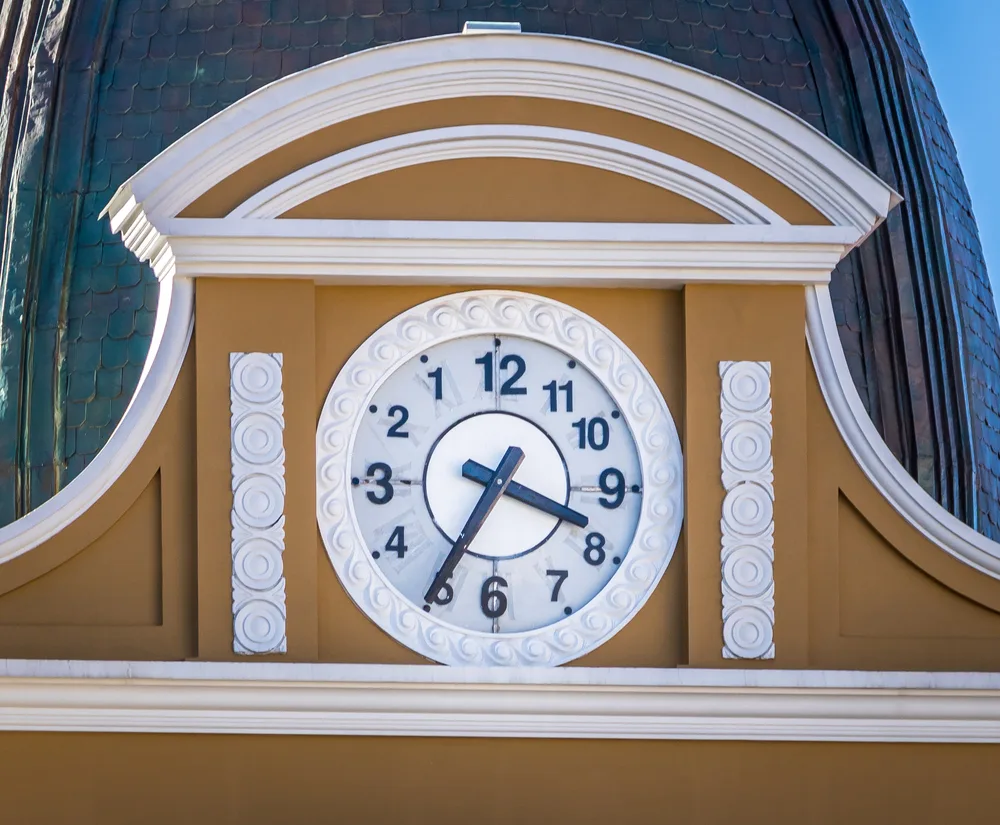
Diego Grandi/Shutterstock
Visit La Paz during your getaway in Bolivia and you’ll notice something strange. The clock in La Paz moves backward. Located on the La Paz Congress building, the clock was intentionally reversed to progress from one through twelve counterclockwise.
The nation’s Foreign Minister insist the clock serves as a reminder for locals to demonstrate irreverence for convention.
10. Bolivia Has Revolutionary Roots
This South American nation’s story is rife with violence and drama. Conquistadors from Spain departed from Europe in the early 16th century and obtained control of Bolivia soon thereafter.
The Spaniards remained in power for nearly three centuries. Locals overthrew their conquistador imperialists in a bloody rebellion that led to its independence.
11. Bolivia Is Home to the World’s Only Bolivianite Mine
Bolivianite mines, also referred to as ametrine mines, consist of quartz. These lovely yellow and purple-hued gems are naturally occurring yet quite rare.
The nation’s ametrine is located in the Anahi mine within the Santa Cruz province. Do a quick internet search for ametrine and you’ll find it is used in jewelry worn by celebrities ranging from Salma Hayek to Japan’s Princess Michiko.
12. Bolivia Is Flamingo Central
Did you know that there are only half a dozen flamingo species? Bolivia is home to six of these fascinating species. Bring your camera along with you on your trip to Bolivia and you’ll have the chance to take snapshots of the nation’s colorful tropical flamingos.
Here, you will find the James, and Andean flamingos, both of which is quite rare outside of this Latin American destination.
13. Bolivia Has Two Capitals
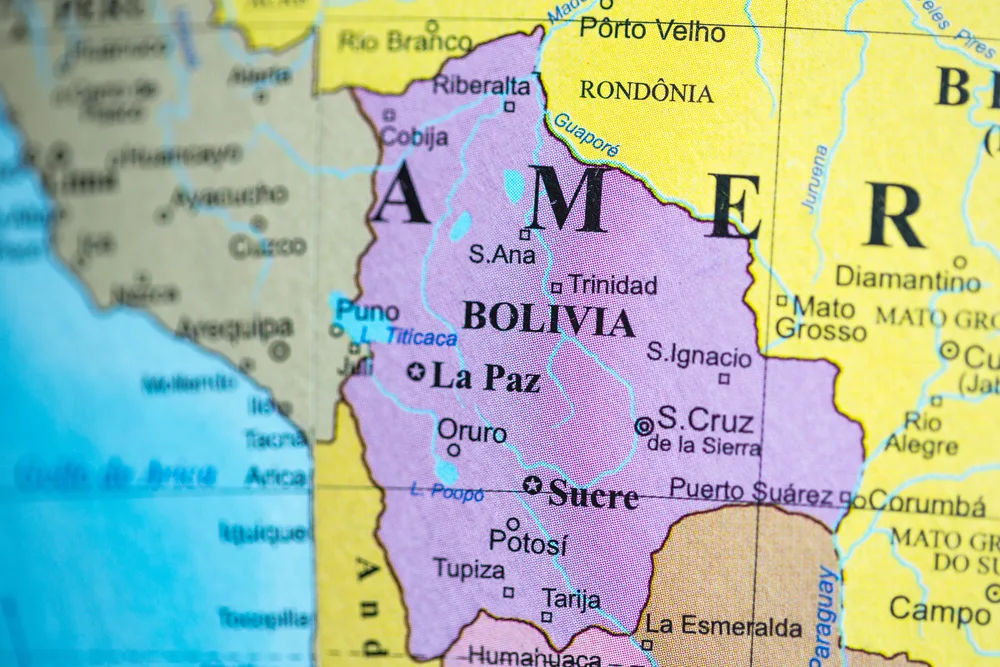
Victor Maschek/Shutterstock
Though it might be hard to believe, Bolivia has two distinct capital cities. Bolivia’s capitals are Sucre and La Paz.
Bolivian internet content often references La Paz as the capital yet this city functions as the nation’s administrative headquarters for bureaucratic purposes. Sucre is the judicial capital of the country, serving as the home of the nation’s Supreme Court.
14. Bolivia Has a Strong Connection to Venezuela
The liberator Simon Bolivar was the motivation for Bolivia’s name. Bolivar hailed from none other than Venezuela.
The militant head of state earned his vaunted reputation for his service in South America’s Wars of Independence. Aside from Bolivia, Bolivar also liberated Peru, Ecuador, Colombia and his homeland of Venezuela.
15. Bolivia Is South America’s Most Affordable Country for Tourists
If you are on the prowl for a new vacation destination that won’t break the bank, consider Bolivia. It simply doesn’t get any more economically efficient for Tourists than this Latin American nation.
Though it will likely cost less money to visit Venezuela, few even consider the nation as it is much more violent and poverty-stricken than nearby countries Choose Bolivia and you’ll spend a fraction of what it would cost to visit Europe’s top destinations.
16. Bolivia Was Previously Called Upper Peru
Upper Peru isn’t exactly the most impactful name for a nation, now is it? Though the moniker doesn’t invoke reverence, it was once the name of what we now know as Peru.
Spanish colonists dubbed modern day Bolivia “Upper Peru” prior to the point at which the nation became independent in the early 19th century. Bolivians went on to change the country’s name in honor of freedom fighter Simon Bolivar.
17. Bolivia Is Home to One Of The World’s Most Spacious Protected Areas
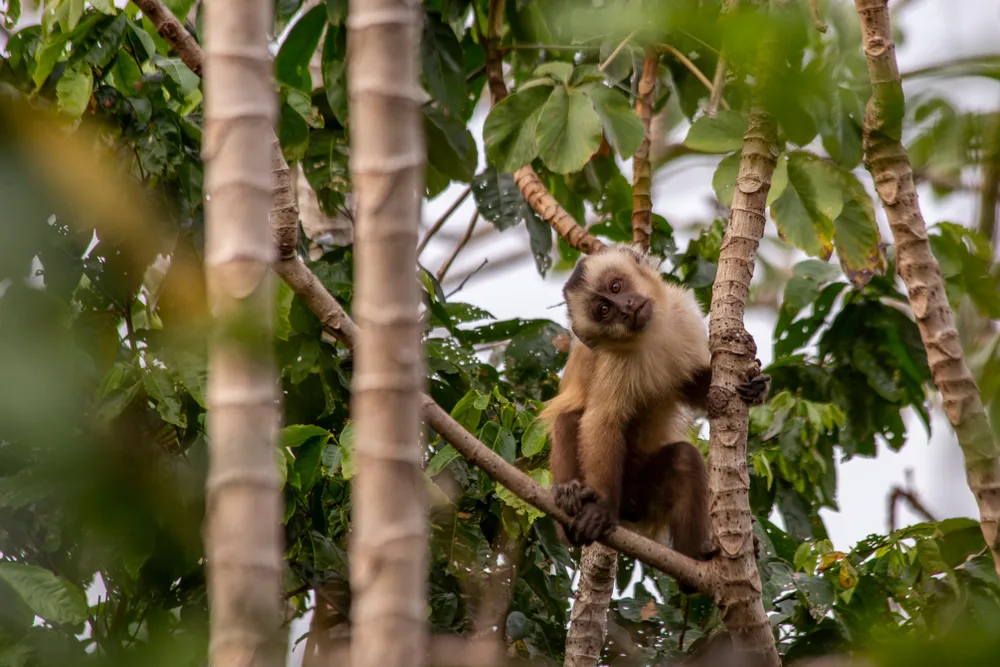
Emiliano Barbieri/Shutterstock
It is a bit surprising that this Latin American nation is the site of Madidi National Park, one of the most expansive protected spaces in all of the world. Positioned in the nation’s Amazon basin, the park is revered for its multitude of fauna and flora.
Nearly 300 known species of mammals are in the park. Previously unidentified animals including rare types of monkeys are discovered in Madidi every year.
18. Bolivia Coca Leaves Are Legal to Consume
Though neighboring nations often consider Bolivia’s coca leaves to be the same as cocaine, you are perfectly free to chomp down on these leaves while in Bolivia. However, it is illegal to take coca leaves out of Bolivia.
Beware that the local coca leaves taste strong as a result of their potent active ingredients. Locals eat the leaves to reduce altitude sickness and pain.
19. Bolivia Is One of Only Two Landlocked South American Countries
Whip out your map of South America, zoom in on Bolivia and you’ll quickly notice it is unique in one regard: the nation is one of only two completely landlocked countries in all of South America.
Locals consider the lack of ocean access to be an injustice as the nation’s 1825 independence meant it controlled desert land that lead to water. Chile conquered this coveted land, taking ownership of the coastline.
20. Bolivians Rock the Pollera Skirt
Those unfamiliar with Bolivia might think Pollera sounds like a tasty Italian dish. Pollera is a skirt worn by native Bolivians as traditional attire.
The skirt is a symbol for the struggle of the Latin American nation’s indigenous women. The garment consists of several colorful layers and is typically worn with a lace blouse, shawl and Panama style hat.
21. Bolivia’s Lake Titicaca Is the World’s Largest Navigable Lake
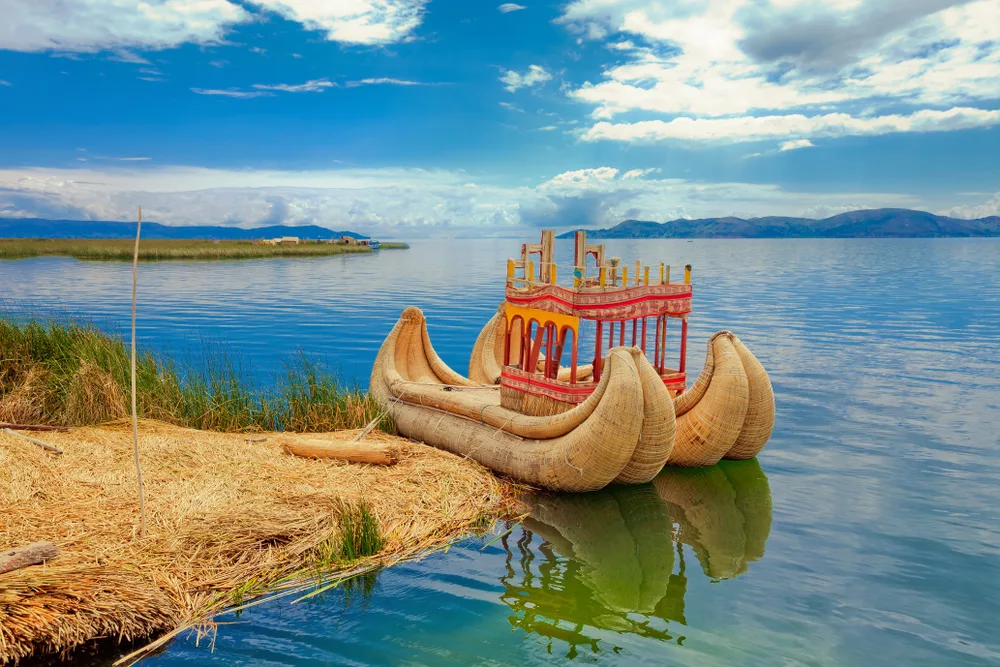
Milton Rodriguez/Shutterstock
Lake Titicaca, located on the nation’s border with Peru, is both the largest and highest (in terms of altitude) navigable lake in Bolivia and beyond. In fact, the lake is the largest in all of South America.
Read up on Lake Titicaca and you’ll find locals consider it to be a sacred spiritual site. Those indigenous to Bolivia believe the lake gave birth to the sun.
22. Bolivia Is Home to the World’s Largest Salt Deposit
If you haven’t been to a salt deposit, you are not alone. Most people have only seen pictures of salt deposits yet Bolivia provides a golden opportunity to visit one.
Bolivia’s Salar de Uyuni is home to the largest salt deposit on the planet. The site is located where a lake once existed in prehistoric times. Climate change dried the lake, leading to the formation of expansive salt crust.
23. The Locals Have a Fondness for Llamas
Most people are intrigued by llamas as these animals have an idiosyncratic look. Bolivians take llama reverence to a new level. There is a twist to Bolivia’s fascination with llamas in that the locals especially revere dead llama fetuses.
Bolivians believe the passing of a llama fetus is a sign of good luck in the near future. Venture out to the La Paz Witch Market and you’ll find some mummified llamas used for ritual purposes.
24. This Latin American Nation Has 30+ Official Languages
If you are bilingual, trilingual or a linguistic savant, you’ll feel right at home in Bolivia. The shocking truth is this Latin American gem has in excess of 30 official languages.
Though most locals are primarily fluent in Spanish, some of the nation’s travel industry professionals speak English and several other languages. All in all, Bolivia’s 2009 constitution notes exactly 37 languages though some of the tongues are no longer spoken.
25. Bolivia Is Home to One of the World’s Highest Cities
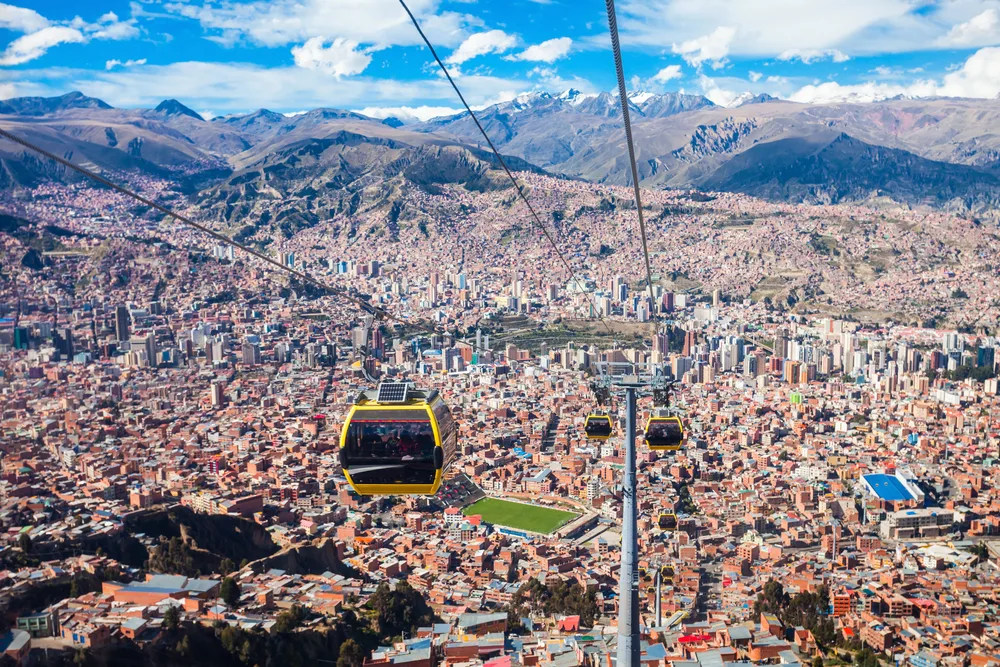
saiko3p/Shutterstock
La Paz, a city with more than a million Bolivians, is one of the world’s highest in terms of elevation. La Paz is a whopping 11,975 feet above sea level.
Though it takes a bit of time for visitors to adjust to the city’s altitude, locals find it quite comfortable. Aside from La Paz, Bolivia is also home to several other cities with relatively high elevations.
If you venture to Uyuni, El Alto, Potosi or Colquechaca, take your time when traversing the terrain and stay hydrated to reduce the chances of altitude sickness.
Frequently Asked Questions
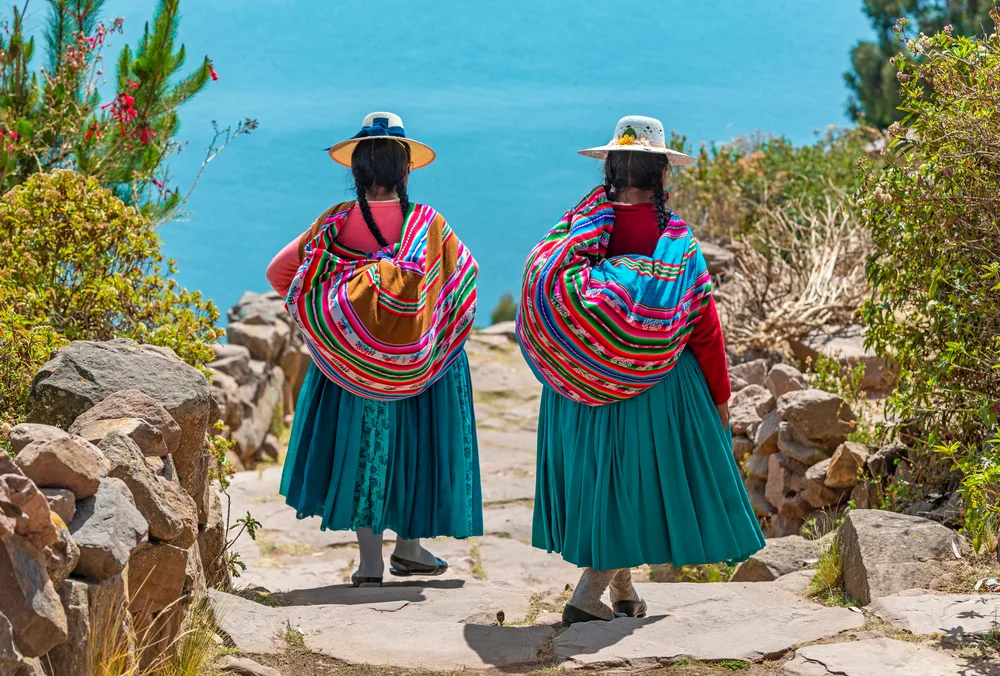
SL-Photography/Shutterstock
Here are some frequently asked questions about Bolivia:
When is the best time to visit Bolivia?
Bolivia is enjoyable throughout the entirety of the year. If you are considering a trip to Bolivia, be mindful of the weather. Head toward the eastern part of the country and you’ll experience lowlands with considerable heat and humidity, especially in the summer. Venture to the highlands is the fall or winter months and you’ll find the high altitude creates cold conditions.
Does Bolivia have its own currency?
Bolivia’s national currency is known as the Peso Boliviano. The country’s ATMs are easily accessible, facilitating the withdrawal of notes in either the national currency and in some cases, United States dollars. Bolivian banks and other money exchange sites make it easy to exchange the United States dollars for Peso Bolivianos.
Does Bolivia have a rich culture?
Yes. Bolivia has more than its fair share of festivals and entertaining cultural activities. Highlights include the late winter and early spring La Diablada Carnival and the cultural highlight of La Paz in the late spring.
Is Bolivia good for tourists?
Indeed, Bolivia is one of the top tourist destinations in Latin America. However, tourists who venture up into the Andean terrain, will experience high altitude that has the potential to cause dizziness. Remain hydrated, avoid caffeinated and alcoholic drinks and take your time when exploring the nation’s undulating terrain.
Are Bolivians friendly to English-speaking tourists?
Bolivians are praised for their hospitality. Some locals are fully or partially fluent in English. However, Bolivia’s official language is Spanish so be sure to brush up on the native tongue before venturing to this Latin American nation.
Over to You — Book Your Trip Today!
So, with so much to see and do, what are you waiting for – book your trip today and experience for yourself all that Bolivia has to offer. Happy travels!



